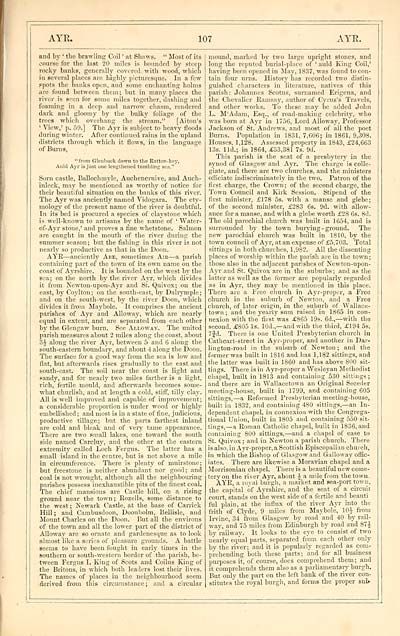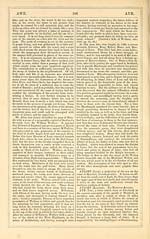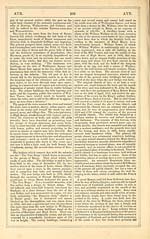Download files
Complete book:
Individual page:
Thumbnail gallery: Grid view | List view

AYR.
107
AYR.
mid by ' the brawling Coil ' nt Shaws. " Most of its
course for the Inst 20 miles is bounded by steep
rocky banks, generally covered with wood, which
in several places are highly picturesque. In a few
spots the banks open, and some enchanting holms
me found between them; but in many places the
river is seen for some miles together, dashing and
foaming in a deep and narrow chasm, rendered
dark and gloomy by the bulky foliage of the
trees which overhang the stream." [Aiton's
' View,' p. 59.] The Ayr is subject to heavy floods
during winter. After continued rains in the upland
districts through which it flows, in the language
of Burns,
" from Glenbuck clown to the Rntton-key,
Aitld Ayr is just one lengthened tumbling sea."
Born castle, Ballochmyle, Auchencraive, and Atich-
inleck, may be mentioned as worthy of notice for
their beautiful situation on the banks of this river.
The Ayr was anciently named A'idogara. The ety-
mology of the present name of the river is doubtful.
In its bed is procured a species of claystone which
is well-known to artisans by the name of ' Water-
of-Ayr stone,' and proves a fine whetstone. Salmon
are caught in the mouth of the river during the
summer season; but the fishing in this river is not
nearly so productive as that in the Doon.
AYR — anciently Are, sometimes Air — a parish
containing part of the town of its own name on the
coast of Ayrshire. It is bounded on the west by the
sea; on the north by the river Ayr, which divides
it from Newton-upon-Ayr and St. Quivox; on the
east, by Coylton; on the south-east, by Dalrymple;
and on the south-west, by the river Doon, which
divides it from Maybole. It comprises the ancient
parishes of Ayr and Alloway, which are nearly
equal in extent, and are separated from each other
by the Glengaw burn. See Allow ay. The united
parish measures about 2 miles along the coast, about
SJ along the river Ayr, between 5 and 6 along the
south-eastern boundary, and about 4 along the Doon.
The surface for a good way from the sea is low and
flat, but afterwards rises gradually to the east and
south-east. The soil near the coast is light and
sandy, and for nearly two miles farther is a light,
rich, fertile mould, and afterwards becomes some-
what churlish, and at length a cold, stiff, tilly clay.
All is well improved and capable of improvement;
a considerable proportion is under wood or highly
embellished ; and most is in a state of fine, judicious,
productive tillage; but the parts farthest inland
are cold and bleak and of very tame appearance.
There are two small lakes, one toward the south
side named Carcluy, and the other at the eastern
extremity called Loch Fergus. The latter has a
small island in the centre, but is not above a mile
in circumference. There is plenty of muirstone;
but freestone is neither abundant nor good; and
coal is not wrought, although all the neighbouring
parishes possess inexhaustible pits of the finest coal.
The chief mansions are Castle hill, on a rising
ground near the town; Rozells, some distance to
the west ; Newark Castle, at the base of Carrick
Hill ; and Cambusdoon, Doonholm, Bellisle, and
Mount Charles on the Doon. But all the environs
of the town and all the lower part of the district of
Alloway are so ornate and gardenesque as to look
almost like a series of pleasure grounds. A battle
seems to have been fought in early times in the
southern or south-western border of the parish, be-
tween Fergus I. King of Scots and Coilus King of
the Britons, in which both leaders lost their lives.
The names of places iu the neighbourhood seem
derived from this circumstance ; and a circular
mound, marked by two large upright stones, and
long the reputed burial-place of ' auld King Coil, 1
having been opened in May, 1837, was found to con-
tain four urns. History has recorded two distin-
guished characters in literature, natives of this
parish: Johannes Scotus, suniamed Erigena, and
the Chevalier Ramsay, author of Cyrus's Travels,
and other works. To these may be added John
L. M'Adam, Esq., of road-making celebrity, who
was born at Ayr in 1756, Lord Alloway, Professor
Jackson of St. Andrews, and most of all the poet
Burns. Population in 1831, 7,606; in 1861, 9,308.
Houses, 1,128. Assessed property in 1843, £24,663
13s. lid.; in 1864, £33,381 7s. 9d.
This parish is the seat of a presbytery in the
synod of Glasgow and Ayr. The charge is colle-
giate, and there are two churches, and the ministers
officiate indiscriminately in the two. Patron of the
first charge, the Crown; of the second charge, the
Town Council and Kirk Session. Stipend of the
first minister, £178 5s. with a manse and glebe;
of the second minister, £283 6s. 9d. with allow-
ance for a manse, and with a glebe worth £28 6s. 8d.
The old parochial church was built in 1 654, and is
surrounded by the town burying - ground. The
new parochial church was built in 1810, by the
town council of Ayr, at an expense of £5,703. Total
sittings in both churches, 1,982. All the dissenting
places of worship within the parish are in the town ;
those also in the adjacent parishes of Newton-upon-
Ayr and St. Quivox are in the suburbs ; and as the
latter as well as the former are popularly regarded
as in Ayr, they mav be mentioned hi "this place.
There are a Free church in Ayr-proper, a Free
church in the suburb of Newton, and a Free
church, of later origin, in the suburb of Wallace-
town ; and the yearly sum raised in 1865 in con-
nexion with tbe first was £865 19s. 6d., — with the
second, £S05 Is. 10d., — and with tbe third, £194 5s.
7fd. There is one United Presbyterian church in
Cathcart-street in Ayr-proper, and another in Dar-
lington-road in the suburb of Newton ; and the
former was built in 1816 and has 1,182 sittings, and
the latter was built in 1S60 and has above 800 sit-
tings. There is in Ayr-proper a Wesleyan Methodist
chapel, built in 1813 and containing 530 sittings;
and there are in Wallacetown an Original Seceder
meeting-house, built in 1799, and containing 605
sittings, — a Reformed Presbyterian meeting-bouse,
built in 1832, and containing 480 sittings, — an In-
dependent chapel, in connexion with the Congrega-
tional Union, built in 1805 and containing 550 sit-
tings, — a Roman Catholic chapel, built in 1836, and
containing 800 sittings, — and a chapel of ease to
St. Quivox; and in Newton a parish church. There
is also, in Ayr-proper, a Scottish Episcopalian church,
in which the Bishop of Glasgow and Galloway offic-
iates. There are likewise a Moravian chapel and a
Morrisonian chapel. There is a beautiful new ceme-
terv on the river Ayr, about £ a mile from the town.
AYR, a royal burgh, a market and sea-port town,
the capital of Ayrshire, and the seat of a circuit
court, stands on the west side of a fertile and heauti
ful plain, at the influx of the river Ayr into the
frith of Clvde, 9 miles from Maybole, 10J from
Irvine, 34 from Glasgow by road "and 40 by rail-
way, and 75 miles from Edinburgh by road and 87^
by railway. It looks to the eye to consist of two
nearly eqiial parts, separated from each other only
by the river; and it is popularly regarded as com-
prehending both these parts; and for all business
purposes it, of course, does comprehend them ; and
it comprehends them also as a parliamentary burgh.
But only the part on the left bank of the river con-
stitutes'the royal burgh, and forms the proper sub-
107
AYR.
mid by ' the brawling Coil ' nt Shaws. " Most of its
course for the Inst 20 miles is bounded by steep
rocky banks, generally covered with wood, which
in several places are highly picturesque. In a few
spots the banks open, and some enchanting holms
me found between them; but in many places the
river is seen for some miles together, dashing and
foaming in a deep and narrow chasm, rendered
dark and gloomy by the bulky foliage of the
trees which overhang the stream." [Aiton's
' View,' p. 59.] The Ayr is subject to heavy floods
during winter. After continued rains in the upland
districts through which it flows, in the language
of Burns,
" from Glenbuck clown to the Rntton-key,
Aitld Ayr is just one lengthened tumbling sea."
Born castle, Ballochmyle, Auchencraive, and Atich-
inleck, may be mentioned as worthy of notice for
their beautiful situation on the banks of this river.
The Ayr was anciently named A'idogara. The ety-
mology of the present name of the river is doubtful.
In its bed is procured a species of claystone which
is well-known to artisans by the name of ' Water-
of-Ayr stone,' and proves a fine whetstone. Salmon
are caught in the mouth of the river during the
summer season; but the fishing in this river is not
nearly so productive as that in the Doon.
AYR — anciently Are, sometimes Air — a parish
containing part of the town of its own name on the
coast of Ayrshire. It is bounded on the west by the
sea; on the north by the river Ayr, which divides
it from Newton-upon-Ayr and St. Quivox; on the
east, by Coylton; on the south-east, by Dalrymple;
and on the south-west, by the river Doon, which
divides it from Maybole. It comprises the ancient
parishes of Ayr and Alloway, which are nearly
equal in extent, and are separated from each other
by the Glengaw burn. See Allow ay. The united
parish measures about 2 miles along the coast, about
SJ along the river Ayr, between 5 and 6 along the
south-eastern boundary, and about 4 along the Doon.
The surface for a good way from the sea is low and
flat, but afterwards rises gradually to the east and
south-east. The soil near the coast is light and
sandy, and for nearly two miles farther is a light,
rich, fertile mould, and afterwards becomes some-
what churlish, and at length a cold, stiff, tilly clay.
All is well improved and capable of improvement;
a considerable proportion is under wood or highly
embellished ; and most is in a state of fine, judicious,
productive tillage; but the parts farthest inland
are cold and bleak and of very tame appearance.
There are two small lakes, one toward the south
side named Carcluy, and the other at the eastern
extremity called Loch Fergus. The latter has a
small island in the centre, but is not above a mile
in circumference. There is plenty of muirstone;
but freestone is neither abundant nor good; and
coal is not wrought, although all the neighbouring
parishes possess inexhaustible pits of the finest coal.
The chief mansions are Castle hill, on a rising
ground near the town; Rozells, some distance to
the west ; Newark Castle, at the base of Carrick
Hill ; and Cambusdoon, Doonholm, Bellisle, and
Mount Charles on the Doon. But all the environs
of the town and all the lower part of the district of
Alloway are so ornate and gardenesque as to look
almost like a series of pleasure grounds. A battle
seems to have been fought in early times in the
southern or south-western border of the parish, be-
tween Fergus I. King of Scots and Coilus King of
the Britons, in which both leaders lost their lives.
The names of places iu the neighbourhood seem
derived from this circumstance ; and a circular
mound, marked by two large upright stones, and
long the reputed burial-place of ' auld King Coil, 1
having been opened in May, 1837, was found to con-
tain four urns. History has recorded two distin-
guished characters in literature, natives of this
parish: Johannes Scotus, suniamed Erigena, and
the Chevalier Ramsay, author of Cyrus's Travels,
and other works. To these may be added John
L. M'Adam, Esq., of road-making celebrity, who
was born at Ayr in 1756, Lord Alloway, Professor
Jackson of St. Andrews, and most of all the poet
Burns. Population in 1831, 7,606; in 1861, 9,308.
Houses, 1,128. Assessed property in 1843, £24,663
13s. lid.; in 1864, £33,381 7s. 9d.
This parish is the seat of a presbytery in the
synod of Glasgow and Ayr. The charge is colle-
giate, and there are two churches, and the ministers
officiate indiscriminately in the two. Patron of the
first charge, the Crown; of the second charge, the
Town Council and Kirk Session. Stipend of the
first minister, £178 5s. with a manse and glebe;
of the second minister, £283 6s. 9d. with allow-
ance for a manse, and with a glebe worth £28 6s. 8d.
The old parochial church was built in 1 654, and is
surrounded by the town burying - ground. The
new parochial church was built in 1810, by the
town council of Ayr, at an expense of £5,703. Total
sittings in both churches, 1,982. All the dissenting
places of worship within the parish are in the town ;
those also in the adjacent parishes of Newton-upon-
Ayr and St. Quivox are in the suburbs ; and as the
latter as well as the former are popularly regarded
as in Ayr, they mav be mentioned hi "this place.
There are a Free church in Ayr-proper, a Free
church in the suburb of Newton, and a Free
church, of later origin, in the suburb of Wallace-
town ; and the yearly sum raised in 1865 in con-
nexion with tbe first was £865 19s. 6d., — with the
second, £S05 Is. 10d., — and with tbe third, £194 5s.
7fd. There is one United Presbyterian church in
Cathcart-street in Ayr-proper, and another in Dar-
lington-road in the suburb of Newton ; and the
former was built in 1816 and has 1,182 sittings, and
the latter was built in 1S60 and has above 800 sit-
tings. There is in Ayr-proper a Wesleyan Methodist
chapel, built in 1813 and containing 530 sittings;
and there are in Wallacetown an Original Seceder
meeting-house, built in 1799, and containing 605
sittings, — a Reformed Presbyterian meeting-bouse,
built in 1832, and containing 480 sittings, — an In-
dependent chapel, in connexion with the Congrega-
tional Union, built in 1805 and containing 550 sit-
tings, — a Roman Catholic chapel, built in 1836, and
containing 800 sittings, — and a chapel of ease to
St. Quivox; and in Newton a parish church. There
is also, in Ayr-proper, a Scottish Episcopalian church,
in which the Bishop of Glasgow and Galloway offic-
iates. There are likewise a Moravian chapel and a
Morrisonian chapel. There is a beautiful new ceme-
terv on the river Ayr, about £ a mile from the town.
AYR, a royal burgh, a market and sea-port town,
the capital of Ayrshire, and the seat of a circuit
court, stands on the west side of a fertile and heauti
ful plain, at the influx of the river Ayr into the
frith of Clvde, 9 miles from Maybole, 10J from
Irvine, 34 from Glasgow by road "and 40 by rail-
way, and 75 miles from Edinburgh by road and 87^
by railway. It looks to the eye to consist of two
nearly eqiial parts, separated from each other only
by the river; and it is popularly regarded as com-
prehending both these parts; and for all business
purposes it, of course, does comprehend them ; and
it comprehends them also as a parliamentary burgh.
But only the part on the left bank of the river con-
stitutes'the royal burgh, and forms the proper sub-
Set display mode to: Large image | Transcription
Images and transcriptions on this page, including medium image downloads, may be used under the Creative Commons Attribution 4.0 International Licence unless otherwise stated. ![]()
| Gazetteers of Scotland, 1803-1901 > Imperial gazeteer of Scotland, or, Dictionary of Scottish topography > Volume 1 > (199) Page 107 |
|---|
| Permanent URL | https://digital.nls.uk/97461518 |
|---|
| Description | Volume I: Aan-Gordon. |
|---|---|
| Attribution and copyright: |
|

